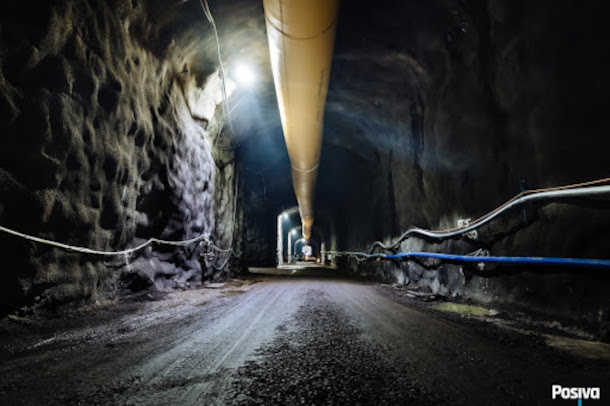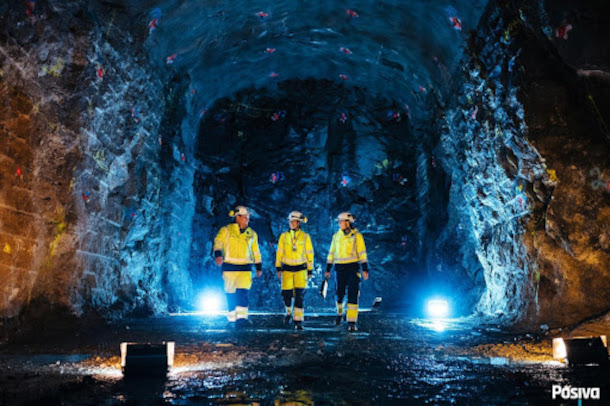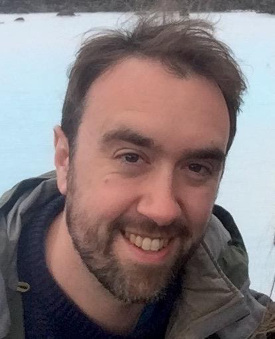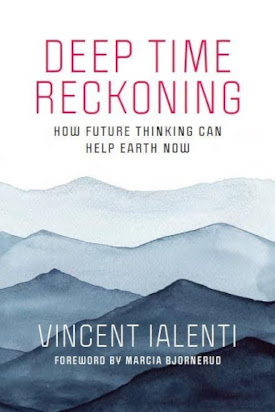Deep Time Reckoning: How Future Thinking Can Help Earth Now
Air Date: Week of July 23, 2021

This nuclear repository on the tiny island of Olkiluoto in Finland holds nuclear waste 400 to 450 meters underground. (Photo: Posiva)
Many of us think in short timescales such as project due Tuesday, a friend’s wedding next month. Rarely do we think about deep time, that is time on a geologic scale. Vincent Ialenti’s book “Deep Time Reckoning” features anthropological fieldwork among people who use deep time frameworks every day: safety experts in Finland working on how to prudently store nuclear power waste, which can be radioactive for millions of years. Ialenti joins host Jenni Doering to discuss the challenges of envisioning scenarios that might happen thousands of years in the future, as well as the benefits of thinking in deep time.
Transcript
BASCOMB: It’s Living on Earth, I’m Bobby Bascomb.
DOERING: And I’m Jenni Doering.
Many of us are used to thinking and living in the now, constantly checking our phones for new emails and texts, making plans for the weekend or stressing over a deadline next week. But the author of the book “Deep Time Reckoning: How Future Thinking Can Help Earth Now” is on a mission to get us to think far beyond. Author Vincent Ialenti profiles “Safety Case” researchers in Finland working on how to safely store nuclear power waste, which can be radioactive for millions of years. That team is envisioning how geology, ecology, society and more could affect an underground nuclear waste repository many millennia in the future. Vincent is an anthropologist who teaches at George Washington University and joins us now. Welcome to Living on Earth!
IALENTI: Great to be here.
DOERING: So first, tell me about this nuclear waste repository in Finland. It's the first in the world, I understand.
IALENTI: That's correct. And people didn't necessarily think it would be. Originally, in the early 1980s when Finland set the schedules for building the repository, it was thought that the United States would come before them, that Canada would be before them, that Sweden might go before them, especially because Sweden made the designs for the repository that's currently being implemented in Finland, they did most of the R&D work. But say whatever you want about Finnish punctuality, it's a, it's widely seen as a very punctual culture, they are the ones who actually kept to the schedule that they set in the early 1980s. And were the first in the world in 2015, to get a construction license for building the world's first spent nuclear fuel repository. Well, what's that? It's 400 to 450 meters underground on a tiny island called Olkiluoto. So they take the nuclear waste from these commercial nuclear power plants, they bring them to an encapsulation plant that they're currently building right now, on site at the Olkiluoto repository. They put them into these big, sort of cast iron insert pieces, and then they take those and put them inside a large copper canister. And then they bring it down 450 meters down here, and they put it in this deposition hole, and they surround it with clay. And that's supposed to absorb the groundwater. And when it does, it expands and it snugly places that nuclear waste underground, hopefully for a very long time, perpetuity. That's the dream.
DOERING: And when you say for a very long time, for hundreds of thousands, millions of years!
IALENTI: Yes, and it's fascinating; I mean, you're dealing with, I mean, the famous ones, Plutonium-239, its half life is 24,100 years, Uranium-235, that's the one you usually talk about when you're talking about nuclear reactors, that's 700 million years.
DOERING: 700 million years of a half life?! That's wild.
IALENTI: [LAUGHS] It certainly is, "wild" is a good word for it. It's interesting; so you look at different repository projects across the world, The Yucca Mountain project in the US, which is now defunct, that has a 1 million year compliance horizon, they have to demonstrate safety of the repository for a million years. The Waste Isolation Pilot Plant in New Mexico, where they store basically transuranic waste, so it's like basically trash, low and intermediate level nuclear waste trash from the post-Manhattan Project and Cold War nuclear weapons production complex, basically contaminated lab coats and instruments, and dirt. They have to prove safety in 10,000 years. Finland takes kind of a mixed approach. They try to envision what the world will look like in the far future on a 10,000-year time horizon on the surface, like lakes, rivers, mires sprouting up; shoreline changing; ecosystem changing; populations moving around. But beneath the surface, sometimes it goes up to 250,000 or more years, and then some of the scenarios that they work on to try to prove the safety of this repository site, one of them's a qualitative scenario, kind of a prose scenario that goes a million years into the future.
DOERING: So can you tell us about the Safety Case project that's working on this repository in Finland? What's it trying to do?
IALENTI: Well, the Safety Case is one unit within Posiva, which is the nuclear waste management company that is implementing this repository. And it's owned by Teollisuuden Voima, TVO, and Fortum, which are two nuclear power holding companies in Finland, they're Finnish companies, and they're part of the long term Safety Department. So they're building this large portfolio of evidence to convince the nuclear regulatory authority of Finland, which is called STUK, that this repository will be safe, or at least we can have a reasonable hope that it will be safe, over tens or hundreds of thousands of years.
DOERING: So Vincent, what really fascinated you about this particular group of experts? Why study them?

The Safety Case experts working at Finland’s Posiva nuclear waste repository access safety scenarios for a distant future — tens or hundreds of thousands of years away — using a deep time framework. (Photo: Posiva)
IALENTI: Well, deep time is kind of this frame we inhabit as we walk through our lives, but we almost never think about. The Safety Case experts, it's normal. It's a little different for them: it's a pile of PDF files in a folder. It's a file of documents, it's models of how, you know, the next Ice Age, there could be a three kilometer thick, glacial ice sheet on top of the repository, pressing it down, and then when it retreats, there could be seismic activity, and will that disturb the waste? Well, that's the job of the Safety Case expert to figure out. So what's fascinating about this group is, these questions are just routine for them. And they're questions that they answer within the everyday boring office timeframes of "Oh, the project is due Friday," and "we have a meeting on Tuesday," and "oh, I got to bring the kid to the dentist on Wednesday." So seeing deep time folded into these everyday, kind of mundane realms of office life becomes a fascinating anthropological case study in my book, for me to go and then pluck little kernels of long termist wisdom, little threads of thought, and kind of retool them, spin them off into little exercises or thought experiments we could do to help us become more robust and talented deep time thinkers ourselves.
DOERING: Yes, I mean, you kind of give us a warning in your book that thinking about deep time like this, it's challenging, it can be distressing. It's, you know, when I think about this repository that is supposed to keep, you know, this waste safe for hundreds of thousands, millions of years, I start to realize, I'm not gonna be around! You know, I'm an ephemeral being, comparatively. How does it sort of make you feel, grappling with these thoughts?
IALENTI: Ah! Well, I'm an ephemeral being too, it's not a good feeling, necessarily! And, you know, it's interesting; I have a line in my book: "Accept futility; reckon deep time anyway." We're all ephemeral beings, we know that what Finn Posiva's doing is ultimately impossible, it's never going to be a perfect representation of the far future. But this is the closest we're gonna get, I believe, to a robust, highly funded, concerted effort to imagine or envision what the far future will be like. And the anthropologist is a good person to navigate this kind of weird epistemic space between, this is plausible science or this is just a credible forecast or this is just pure speculation, or, some aspects of it are quite convincing; other aspects are not. But what's also interesting is that the Safety Case experts have this humility to them too. Reckoning deep time is partially about hubris, thinking that you're, [LAUGHS] that you can actually think a little about the future, when it could change. But it's also partially about humility, and checking yourself. For example, they had this thing called knowledge quality assessment that they did on some of their models, where they would basically try to bound their assumptions and critique their own models, saying like, here are the gaps we created. So entering in this self reflective, self critical spirit is the first step to being a deep time reckoner.
DOERING; So, Vincent, I'm not a nuclear waste expert, and I doubt most of our listeners are. One of the tools that they use is analogies. Could you give us some examples of those analogies and why they were so important?
IALENTI: Safety Case experts are concerned or have to be concerned about the next Ice Age, because there's gonna be a large glacial ice sheet, most likely, in Finland, possibly three kilometers thick, weighing upon where the repository is going to be. They say, when I was in the field, it was 50 or 60,000 years from now, was where they were reckoning this would happen. You can't really study it in situ, on site, right? You have to go somewhere in the present where there actually is a glacial ice sheet. So what they do is they team up with Sweden, they team up with Canada, and then they go to Kangerlussuaq, Greenland, and they study a present-day glacial ice sheet as an analogue for a far future Finnish ice sheet. They look at how it melts, they look at its permafrost, they look at what happens when it retreats, and they make extrapolations using the power of analogy about how the far future Finnish ice sheet may be. And that's just one example. They look to archaeological artifacts as well, right? So they would look to Swedish warship Kronan, which sunk in the 17th century in a battle of Oland, and cannon fell out, and half of it's in the seabed, and then half of it's corroding a little bit in the seawater. They lifted this thing up, and then studied this bronze cannon from this old shipwreck as an analogue for the far future fate of a copper canister in the nuclear waste repository, the canister they're putting Finland's nuclear waste in. It's taking a present day artifact, learning about its past, in order to make projections about the future.
DOERING: So how can we in our everyday lives do some of this thought experimentation, of thinking long term? And why should we?

Vincent Ialenti is a MacArthur Postdoctoral Fellow at The University of British Columbia and an Assistant Research Professor at George Washington University. (Photo: MIT Press)
IALENTI: That's the challenge of my book as an anthropologist. Analogies was kind of my way there, these natural analogue studies and archaeological analogue studies. There's nothing arcane or esoteric or highly technical about the power of analogy itself. So I started looking for analogies in my own life, to try to distance myself from the now, and then expand my time consciousness and temporal awareness. For example, when I would, loved hiking around the Appalachian Mountains, I'd go out to Shenandoah and to West Virginia, and you know, western parts of Virginia, these large rolling hills. They're mountains, but they're not, you know, they're not quite the Rockies, they're not as tall. But at some point in geological history, they sure were! I start thinking of the imageries I have of the Alps, or the Himalayas, or taller mountains today, or the Rockies, to try to imagine this area with much taller mountains. That takes my walk, and then enchants it with deep time, or geological time. And it's, it can be meditative. It can be contemplative, and it can be consciousness expanding to do this. And all of this is directly inspired by the spirit of the Finnish nuclear waste experts, analogue Safety Case experts.
DOERING: Wow. We are at this unique, unprecedented time where we can look back so far in the past, thanks to geologists who, you know, tell us what the earth used to look like. And physicists who know how the universe began. And we can also imagine far into the future, thanks to people like the Safety Case project experts in Finland. So Vincent, one of the big challenges with safely storing nuclear waste for a really long time, is how to warn far future generations about it, how to communicate that. I mean, they might not even use the same symbols, let alone language that we do. So how have nuclear experts been approaching this in their work?
IALENTI: Well, it's different in different countries. In the United States, with the Yucca Mountain high level nuclear waste repository project that is now mostly defunct, or stagnated, depending who you ask. And then with the WIPP, the Waste Isolation Pilot Plant, which is transuranic nuclear weapons waste. But both of those projects, WIPP and Yucca, the Department of Energy and Bechtel and their various subcontractors did some pretty outlandish and fascinating inquiries. The question was, how do you build a monument at the site to warn people not to dig there? Well, some ideas were, you put this huge, terrifying monument of thorns, because thorns are scary, everyone knows that thorns are bad, and you put it over the site, black thorns, scare everyone. Other people were like, let's put a huge slab with loads of different languages on it that says, "Do not dig here, this is a dangerous place of terror." But languages don't even last that long, compared to the multi-millennial half lives of nuclear waste, right? Languages change. So that becomes a problem, too. Other people have suggested to establish a quote-unquote, "Atomic Priesthood," where people go out into the desert once a year, and at the site, and recite this sort of oral history mode, "Do not dig here, this is a place, we are the protectors, we have to tell society." Because you know, oral histories last a really long time. One person proposed bioengineering cats, so they change colors when they're in contact with radiation. And then you also release lots of folklore into the area that says, I don't know what it would be, but maybe it's like, "Green cat, stay away, brown cat, you're okay," or something. And everyone knows that when you see that color cat -- So this is just the type of thinking that comes up when you expand your time horizon that long. So, Finland, what's fascinating is, they don't do that! [LAUGHS] They think it's hubris. Not, I don't want to speak for everyone, but the project doesn't do it. Their idea is, bring it to the island of Olkiluoto, and just put it in a place where there's not many resources, where no one will want to dig, and then bury it. And then in 2120, when you're done, cap it off, or whenever you happen to be done, who knows when it'll actually be done, and then forget.
DOERING: Wow, and we'll never know if it works or not, I guess we'll be dead! [LAUGHS]
IALENTI: That's right. That's the spirit!
DOERING: So you also talk in your book about this idea of the "deflation of expertise," really a dangerous thing that's been happening. Could you tell us about what you mean by that?

Deep Time Reckoning (MIT Press, 2020) uses anthropological studies of Finland’s nuclear waste repository to discuss strategies for imagining and envisioning potential far future worlds. (Photo: MIT Press)
IALENTI: Sure can. So when I return to the United States, I see mass populist fervor against elites, and there's many reasons for it, and some of them quite understandable. But seeing science being brushed off in this as well, that's kind of what I saw when I came back from Finland, which is a place that has a generalized trust for expertise that you don't see elsewhere. And this can't be detached from the public acceptance of Finland's repository. The entire Finnish nuclear complex was under the Ministry of Employment and Economy, one of the most trusted organizations in the country. Ultimately, the organization that signs off on, can you build a repository, can it accept waste and gives you that permit is the Ministry of Employment and Economy, so trusted. And you didn't see the NIMBY, not-in-my-backyard politicking that you saw with the Yucca Mountain project, and in so many other countries that were supposed to go before Finland, or planned to go before Finland in becoming the world's first nuclear waste repository project. Part of that is the trust culture. Another part of it is Finland had a mature consent-based siting approach. And that means the Finnish nuclear experts respected the public enough to go out to the Olkiluoto community, do a lot of public hearings, listen to what concerns were in the community, in Western Finland. And then literally integrate some of their concerns, technical concerns, even if the scientists brushed them off. They said, "Nope, we're gonna study it anyway." This is in the late '90s and early 2000s. And they listen to the public and then do an environmental impact that directly responds to some of the local anxieties and concerns about the repository. This is a participatory and consent based siting procedure. The crucial part at the end, is the municipality can say no! They can say, "Sorry, you just spent all this money, but we don't want it here." And trusting the locals and the community to say, we don't want it here is so different than what happened in Nevada with the Yucca Mountain project. In that context, the Department of Energy did a decide-announce-defend approach, it was called the "Screw Nevada Bill," in Nevada. They put it in a state with a low amount of electoral votes, it was a place right near Indigenous communities. And it was one of the most nuclear bombed places on earth, it was right near the Nevada Test Site. And since then, here's a reason we shouldn't trust science too much, or trust that science will be responsibly used too much, is that hundreds of nuclear tests have occurred in that site, and the fallout went all across the United States and all across the world, eventually, from nuclear weapons testing out there. Now, there's political resistance in Finland to the new reactor they're buying from Russia. But the actual nuclear waste repository was not really politically charged, and rejected on NIMBY grounds.
DOERING: So Vincent, before you go, to what extent do you think that long termism and thinking in deep time is ultimately connected to our survival as a human species?
IALENTI: It's closely connected to it. We're living in a moment of a global climate crisis. We're living in a moment of dwindling biodiversity. We're living in a moment of rapid short-termism, people focused on 24-hour news cycles, 24/7 news cycles, people waiting for the next tweet, people getting caught up staring at screens. But the consequences we're creating for humanity, be they microplastics, be it nuclear waste, are extremely long term. I am not a hard scientist or a physical scientist, so I don't produce solutions in how to reverse these things. So making deep time or geological time more at the level of your everyday experience, more a rubric or a framework, or a set of strategies or tactics that someone can pick up and then use in their everyday life to distance themselves from the now: that's my project. And I think that's the kind of intellectual and imaginative education we need to achieve for ourselves if we're going to be a population that can steward a planet, at least for a few more generations. And ideally, for many more than that.
DOERING: Vincent Ialenti is the author of Deep Time Reckoning: How Future Thinking Can Help Earth Now, and a research professor at George Washington University. Thank you so much, Vincent.
IALENTI: Yeah, it was great to be here, I really enjoyed the conversation.
Links
More about Deep Time Reckoning
Learn more about Posiva and Final Disposal
BBC | “The Benefits of Embracing 'Deep Time' In A Year Like 2020”
Living on Earth wants to hear from you!
Living on Earth
62 Calef Highway, Suite 212
Lee, NH 03861
Telephone: 617-287-4121
E-mail: comments@loe.org
Newsletter [Click here]
Donate to Living on Earth!
Living on Earth is an independent media program and relies entirely on contributions from listeners and institutions supporting public service. Please donate now to preserve an independent environmental voice.
NewsletterLiving on Earth offers a weekly delivery of the show's rundown to your mailbox. Sign up for our newsletter today!
 Sailors For The Sea: Be the change you want to sea.
Sailors For The Sea: Be the change you want to sea.
 The Grantham Foundation for the Protection of the Environment: Committed to protecting and improving the health of the global environment.
The Grantham Foundation for the Protection of the Environment: Committed to protecting and improving the health of the global environment.
 Contribute to Living on Earth and receive, as our gift to you, an archival print of one of Mark Seth Lender's extraordinary wildlife photographs. Follow the link to see Mark's current collection of photographs.
Contribute to Living on Earth and receive, as our gift to you, an archival print of one of Mark Seth Lender's extraordinary wildlife photographs. Follow the link to see Mark's current collection of photographs.
 Buy a signed copy of Mark Seth Lender's book Smeagull the Seagull & support Living on Earth
Buy a signed copy of Mark Seth Lender's book Smeagull the Seagull & support Living on Earth

